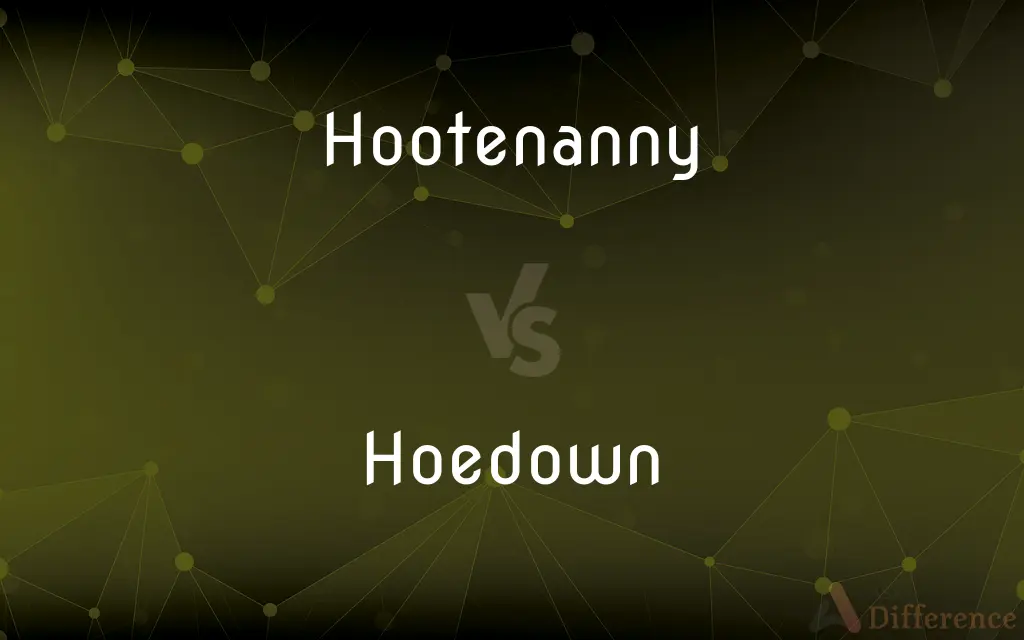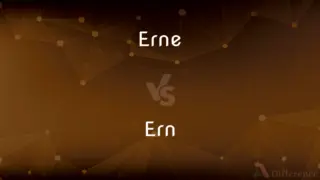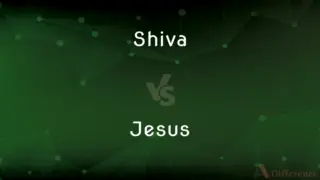Hootenanny vs. Hoedown — What's the Difference?
By Tayyaba Rehman & Fiza Rafique — Updated on April 1, 2024
Hootenanny refers to an informal gathering featuring folk music and sometimes dancing, while a hoedown is a traditional American folk dance or party where such dances are performed, often accompanied by country or bluegrass music.

Difference Between Hootenanny and Hoedown
Table of Contents
ADVERTISEMENT
Key Differences
Hootenanny originally emerged as a Scottish word for "thingamajig" but evolved in the United States to describe an informal folk music gathering, where musicians might share songs, often with political or social messages. In contrast, hoedowns are rooted in American folk dance traditions, specifically linked to rural and agricultural communities.
While both terms describe social gatherings centered around music and, occasionally, dance, the hootenanny emphasizes the musical and communal aspect, inviting participation from attendees in a casual setting. The hoedown, however, places a greater emphasis on the dance element, with structured dances like square dancing being a common feature. The music played at a hoedown is instrumental in guiding the dancers through various routines and steps, making the musical component both central and functional.
The settings for these events also differ; hootenannies can occur in a wide range of venues, from someone's living room to a public park, without the need for a formal stage or setup. Hoedowns, however, are typically held in spaces that can accommodate dancing, such as barns, community halls, or open fields. These venues are chosen with the dance component in mind, ensuring there's ample space for participants to engage in the physical activity.
Despite their differences, both hootenannies and hoedowns serve to bring communities together through music and dance. They reflect the cultural heritage and social customs of their respective origins, highlighting the importance of communal entertainment and cultural expression in American history.
In contemporary times, the lines between hootenannies and hoedowns have blurred, with both terms being used interchangeably in some contexts. However, traditionalists might still make a distinction based on the specific characteristics of the music, the presence and type of dance, and the overall atmosphere of the gathering.
ADVERTISEMENT
Comparison Chart
Origin
Scottish term adapted in the US for folk music gatherings.
American folk dance tradition.
Main Focus
Music and communal participation.
Dance, especially square dancing, to country or bluegrass music.
Typical Music
Folk music, often with political or social themes.
Country or bluegrass music guiding structured dances.
Venue
Any casual setting, from homes to public parks.
Spaces accommodating dance, like barns or community halls.
Community Aspect
Emphasizes participation and enjoyment of music.
Brings communities together through dance and music.
Compare with Definitions
Hootenanny
A social event emphasizing community participation in music.
The local coffee shop organizes a hootenanny every Friday night where local musicians can showcase their talents.
Hoedown
A lively, energetic event.
The barn was alive with energy during the hoedown, as couples twirled to fast-paced fiddle music.
Hootenanny
An informal gathering featuring folk music, where people may sing along or perform.
We're hosting a hootenanny this weekend to celebrate folk music traditions.
Hoedown
Specifically refers to dance events with a structured pattern.
At the hoedown, experienced callers led the crowd through various square dances.
Hootenanny
Can include storytelling and poetry.
Aside from music, tonight's hootenanny will feature poets and storytellers sharing their work.
Hoedown
A party or dance event focusing on country, bluegrass, or folk music, with square dancing.
The annual hoedown attracted visitors from neighboring towns for a night of dance and music.
Hootenanny
Often associated with progressive movements.
The hootenanny served as a gathering space for discussing social issues through music.
Hoedown
Celebrates rural American culture.
The hoedown featured traditional Appalachian music and dances.
Hootenanny
A hootenanny is a party involving music in the United States. It is particularly associated with folk music.
Hoedown
To dance a hoedown dance
Hootenanny
An informal performance by folksingers, typically with participation by the audience.
Hoedown
A hoedown is a type of American folk dance or square dance in duple meter, and also the musical form associated with it.
Hootenanny
(Informal) An unidentified or unidentifiable gadget.
Hoedown
A square dance.
Hootenanny
(music) An informal, festive performance by folk singers, often including audience participation with the use of acoustic instruments.
Jam session
Hoedown
The music for a square dance.
Hootenanny
(obsolete) A placeholder word for a nonspecific or forgotten thing.
Hoedown
A social gathering at which square dancing takes place.
Hootenanny
An informal social gathering or concert featuring mostly folk songs, sometimes dancing, and where the audience often participates in the singing.
Hoedown
A type of American folk or square dance.
John and Susie went to the square dance and did the hoedown.
Hootenanny
Same as whatchamacallit; a thingumbob.
Hoedown
The type of music typically played for such a dance
Hoedown
A gathering at which such dances take place.
We have to get to the hoedown before noon, or we'll be late.
Common Curiosities
Can anyone participate in a hootenanny?
Yes, hootenannies are open and participatory, encouraging everyone to join in the music-making.
What kind of music is played at a hootenanny?
Folk music, often with political or social themes, is typically played at a hootenanny.
What is a hoedown dance like?
A hoedown dance is lively and structured, often featuring square dancing and other traditional American folk dances.
Do I need to know how to dance to attend a hoedown?
No, hoedowns often include callers who guide participants through the dances, making them accessible to beginners.
Are hootenannies suitable for children?
Yes, hootenannies are family-friendly events focused on music and community.
Are hoedowns only held in rural areas?
While hoedowns have rural roots, they can be held anywhere that can accommodate dancing, including urban community halls.
Is there a difference between the instruments used in hootenannies and hoedowns?
The choice of instruments might overlap, but hootenannies often feature acoustic instruments like guitars and banjos, while hoedowns may include a wider range of instruments to support dance music.
How can I find a hootenanny or hoedown near me?
Check local event listings, community bulletin boards, or folk and country music clubs and organizations.
What should I wear to a hoedown?
Comfortable clothing that allows for movement, and shoes suitable for dancing. Traditional attire, like cowboy boots, is optional.
Is alcohol served at these events?
The availability of alcohol depends on the venue and the event organizers. Some events may include it as part of the gathering, while others may not.
How have hootenannies and hoedowns evolved over time?
Both have adapted to contemporary tastes while maintaining their traditional roots, with music and dance styles evolving to reflect current trends.
Are these events formal or informal?
Both hootenannies and hoedowns are generally informal, focusing on community participation and enjoyment rather than formal presentation.
Can hootenannies include other forms of entertainment?
Yes, while music is the focus, hootenannies may also include storytelling, poetry reading, and other forms of communal entertainment.
Can these events be held indoors and outdoors?
Yes, both hootenannies and hoedowns can be held in indoor or outdoor settings, depending on the space and the organizers' preferences.
What is the social significance of hootenannies and hoedowns?
They serve as cultural expressions of community and tradition, fostering social bonds and celebrating American folk heritage.
Share Your Discovery

Previous Comparison
Erne vs. Ern
Next Comparison
Shiva vs. JesusAuthor Spotlight
Written by
Tayyaba RehmanTayyaba Rehman is a distinguished writer, currently serving as a primary contributor to askdifference.com. As a researcher in semantics and etymology, Tayyaba's passion for the complexity of languages and their distinctions has found a perfect home on the platform. Tayyaba delves into the intricacies of language, distinguishing between commonly confused words and phrases, thereby providing clarity for readers worldwide.
Co-written by
Fiza RafiqueFiza Rafique is a skilled content writer at AskDifference.com, where she meticulously refines and enhances written pieces. Drawing from her vast editorial expertise, Fiza ensures clarity, accuracy, and precision in every article. Passionate about language, she continually seeks to elevate the quality of content for readers worldwide.
















































